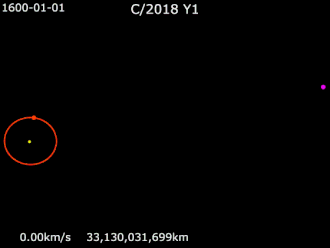
Back Wentelbaan Afrikaans Umlaufbahn ALS Orbita AN مدار Arabic ܫܒܝܠܐ (ܡܡܠܠܘܬ ܟܘܟܒܐ) ARC Órbita AST Orbit Azerbaijani اوربیت AZB Арбіта Byelorussian Арбіта BE-X-OLD

In celestial mechanics, an orbit (also known as orbital revolution) is the curved trajectory of an object[1] such as the trajectory of a planet around a star, or of a natural satellite around a planet, or of an artificial satellite around an object or position in space such as a planet, moon, asteroid, or Lagrange point. Normally, orbit refers to a regularly repeating trajectory, although it may also refer to a non-repeating trajectory. To a close approximation, planets and satellites follow elliptic orbits, with the center of mass being orbited at a focal point of the ellipse,[2] as described by Kepler's laws of planetary motion.
For most situations, orbital motion is adequately approximated by Newtonian mechanics, which explains gravity as a force obeying an inverse-square law.[3] However, Albert Einstein's general theory of relativity, which accounts for gravity as due to curvature of spacetime, with orbits following geodesics, provides a more accurate calculation and understanding of the exact mechanics of orbital motion.
- ^ "orbit (astronomy)". Encyclopædia Britannica (Online ed.). Archived from the original on 5 May 2015. Retrieved 28 July 2008.
- ^ "The Space Place :: What's a Barycenter". NASA. Archived from the original on 8 January 2013. Retrieved 26 November 2012.
- ^ Kuhn, The Copernican Revolution, pp. 238, 246–252